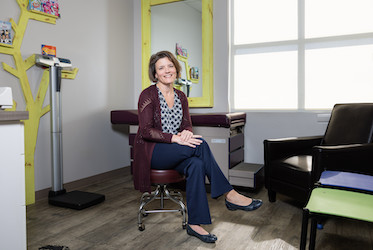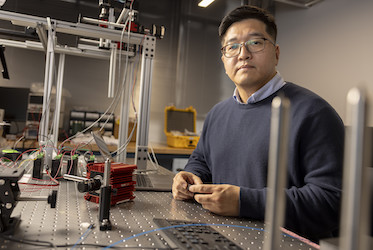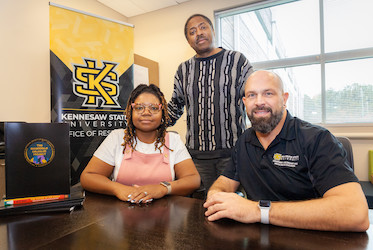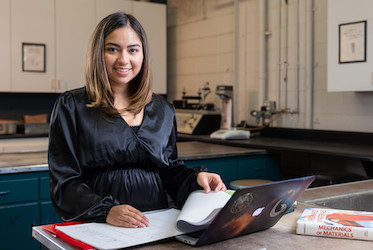
Designing a Better World
MARIETTA, Ga. | Apr 28, 2020
Engineering Technology capstone projects tackle universal problems
At the beginning of the spring semester, electrical engineering technology professor Scott Larisch issued a challenge to his senior capstone students: build a product that will improve the world around them.
They responded by creating a forest-fire-hunting drone, a robotic service animal, a football helmet capable of detecting concussions and a device that can convert text messages into braille, among other equally impactful projects.
“I think it is a testament to the diversity of our Engineering and Engineering Technology student body that they came up with such a wide variety of projects,” said Larisch, assistant chair of Kennesaw State University’s Department of Engineering Technology. “We often define engineering as the ability to produce products and services that benefit society, and I can say with confidence that each of my class' projects meets that definition.”
The senior capstone process is one of the most important aspects of the undergraduate educational journey, Larisch said, adding that it is not unlike a semester-long episode of the TV series Shark Tank. In order to complete the project, students are tasked with identifying a problem, developing a solution and demonstrate it, incorporating knowledge they’ve acquired not only from their major coursework, but also mathematics, science, communications, humanities and arts classes, too. As a requirement, student teams must also defend why the device is needed in a social, environmental, economic and global context. While Larisch judged projects on whether the technical challenge was sufficient and achievable, the students were given the freedom to show how best to apply their skills to solve leading problems.

For Brooke Oden, it was finding a way to improve connectivity for the visually impaired. Her team, composed of Levi Ford, Doug McGinnis and Wesley Inman, created Bluetooth-capable device that can convert text messages into braille for the deaf-blind community. The device works by transmitting data to the box, which triggers tiny embedded nodes to rise out of the box spelling out messages using the braille alphabet.
“I’ve always been really interested in Bluetooth connectivity and smart devices, and I think we realized that these kinds of devices can really enrich the lives of others by making it easier to communicate,” she said. “If there was a way we could help the visually impaired better communicate with others, we were going to tackle it through this project.”
Another team, composed of John Copeland, Austin Dudman, Kevin Hampton and Luis Serge-Olivier Geralda Tutab, sought to build a compact vehicle that can serve as a companion to the mobility impaired, carrying and retrieving objects for them.
“Throughout the brainstorming process, our professor was very big on making sure our projects had the potential to make a positive impact on society,” Copeland said. “Our focus was to create something that would aid the disabled, and we ultimately landed on a device that can help someone carry objects hands free.”
While the capstone process can prove to be rigorous under normal conditions, the process saw a new challenge this semester with the move to remote learning in the wake of COVID-19. Normally meeting in person to build and test their products, student teams moved their work into an online environment while continuing to develop a proof-of-concept.

Ford said they were able to pivot by discussing new developments over video chats and by sharing important software updates through GitHub.
“The fact that we weren’t able to meet and show what we’ve accomplished physically was frustrating at times, but at the end of the semester, we are all pretty satisfied with what we were able to accomplish given the circumstances,” Ford said. “From a project-management perspective, I think this has been a great experience and perhaps one of the most useful classes we have been asked to take so far. I think we’re all going to come out of this with a little more respect for our project managers or have the aptitude to do it ourselves.”
Dudman, whose team built the robotic service animal, said the experience has taught him how to problem-solve, which is an invaluable skill for those in engineering technology.
“I would say one of the biggest takeaways from this process is learning how to communicate among the team and to overcome barriers, particularly at a time where we aren’t able to physically meet outside of our homes,” he said. “All of us have certainly worked in group settings before this course, but this project was a unique challenge, and I’m glad to have been able to work through this with my teammates. The experience will no doubt follow me throughout my career.”
– Travis Highfield
Photos submitted
Related Stories

Kennesaw State researcher applies mathematical modeling expertise to health care systems

Kennesaw State receives grant to help children with sickle cell disease

Kennesaw State receives $2.5 million grant to foster student success in calculus

Kennesaw State engineering graduate has literally come a long way
A leader in innovative teaching and learning, Kennesaw State University offers undergraduate, graduate and doctoral degrees to its more than 45,000 students. Kennesaw State is a member of the University System of Georgia with 11 academic colleges. The university’s vibrant campus culture, diverse population, strong global ties and entrepreneurial spirit draw students from throughout the country and the world. Kennesaw State is a Carnegie-designated doctoral research institution (R2), placing it among an elite group of only 7 percent of U.S. colleges and universities with an R1 or R2 status. For more information, visit kennesaw.edu.















